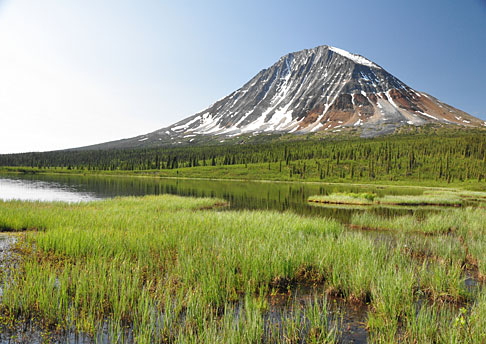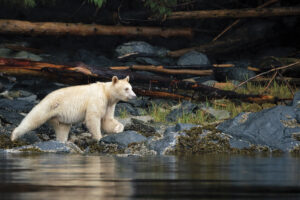
People & Culture
Kahkiihtwaam ee-pee-kiiweehtataahk: Bringing it back home again
The story of how a critically endangered Indigenous language can be saved
- 6310 words
- 26 minutes
This article is over 5 years old and may contain outdated information.
People & Culture

On the Prime Minister’s seventh annual northern tour in August, Mary Jane Starr of the Royal Canadian Geographical Society (RCGS) sat down for an interview with Stephen Harper at a picnic table on the grounds of the Norman Wells Historical Society in the Northwest Territories. The following is an edited transcript of the conversation, which touched on the past, present and future of Canada’s North.
RCGS: The tour’s five-day itinerary includes Whitehorse, Norman Wells, NWT, Cambridge Bay, Nunavut, and Churchill, Man., with additional stops in the newest national park and the oldest settlement on Hudson Bay. What is behind this ambitious agenda?
PM: As a Canadian, I’ve always been interested in this country’s history and geography. I find it fascinating. Geography is one of the things Canada is about, particularly northern geography.
RCGS: This is your seventh northern tour. What draws you back each year?
PM: I love the North. It is really very diverse and it defines our country in many ways. I wish Canadians could see the extent, the diversity and the wealth of the North.
RCGS: In addition to your summer tour, you have been to innumerable communities in the North on other occasions. Do you have any favourite places?
PM: As I said earlier, the North is a diverse region that encompasses two distinct areas, the boreal forest and the Arctic, another land altogether. I would describe Yellowknife, for example, as a small city that is very habitable, not unlike small cities in the south. At the other extreme is Alert, Nunavut, literally an outpost and, as such, life there is more dangerous and difficult. Norman Wells represents yet another kind of community, one that is more frontierish.
RCGS: You recently announced a new national park, the Nááts’ihch’oh National Park Reserve in the Northwest Territories. Why create another national park?
PM: National parks are part of our identity and our priceless inheritance. This new park is breathtaking and has tremendous natural and cultural importance. Any day there is a park announcement is a good day.
RCGS: The new park is about the same size as Vancouver Island and can only be reached by float plane or canoe. Given the inaccessibility of some national parks, how can more Canadians experience them?
PM: I think it’s a broader question and it does concern me: how do we get more Canadians to experience our country? When I was a boy, we drove a lot in Canada, visiting a lot of conservation areas. It was how we did our family vacations, and we probably did it more than most. Now the common thing is to hop on a plane to somewhere else. It’s an expensive country to get around but we still can get around parts of it quite reasonably.
RCGS: Our Society’s motto is “Making Canada better known to Canadians and to the world.” Is this consistent with your views?
PM: I wish Canadians would see more of their country and get a greater appreciation of the extent of it, the diversity and the wealth that the land has given us historically and that is still the basis of much of the country’s economy today. There are a group of Canadians who have become more and more passionate about the wilderness and about seeing the country. At the same time, a wider swath is seeing less and less of the country by choice. Anything we can do to give Canadians a sense of the breadth, perspective and nature of the country, the better.
RCGS: Part of Canadians’ connection with the North derives from its past — from its incomparable geography and history. During the northern tour, you announced a renewed investment in the search for the missing ships of the Franklin expedition. Why the continuing interest?
PM: The Franklin expedition is a tragic story. It represents a seminal moment in Canada’s history and a key component of our Arctic sovereignty. The HMS Erebus and the HMS Terror are together a national historic site that to date is undiscovered. Searching for Franklin’s ships may seem like looking for a needle in a haystack but the ships will be found. We have an obligation to do so.
RCGS: Before Franklin set sail in search of the Northwest Passage, there was already a settlement on the shore of Hudson Bay at York Factory. What was its importance?
PM: York Factory is one of the geographical treasures of the country. It was the capital town of Western Canada for 200 years. At one time, it was a bustling community and a centre of commerce and immigration. In fact, modern Western Canada begins at York Factory. Now there are only a couple of main buildings, some artefacts and a cemetery. The challenge currently is to ensure that the site is not further eroded.
RCGS: York Factory appears to be isolated and far removed from other communities but isn’t there a connection to the Franklin expedition?
PM: That’s right. Inscribed on a post on the ground floor of the interior of the main building at York Factory is the name John Rae. Rae, of course, was a leader of the overland expedition that searched for Franklin.
RCGS: Readers of Canadian Geographic have a high degree of interest in Canada’s North. Does this surprise you?
PM: Not at all. Canada’s North is an incredibly vast and still harsh environment. You can fly for hours and hours and never see any indication of human settlement or activity. Yet Canadians are attached to this part of the country. Someone said, “I’ve never been to James Bay part but it’s part of my identity.” The North is imprinted on the imagination of Canadians. It is central to our identity. The land is endless and so are the possibilities. I always say our biggest dreams are at the highest latitudes.
Are you passionate about Canadian geography?
You can support Canadian Geographic in 3 ways:

People & Culture
The story of how a critically endangered Indigenous language can be saved

People & Culture
The death of an unhoused Innu man inspired an innovative and compassionate street outreach during the nightly curfew in 2021

History
A look back at the early years of the 350-year-old institution that once claimed a vast portion of the globe

Wildlife
How ‘maas ol, the spirit bear, connects us to the last glacial maximum of the Pacific Northwest